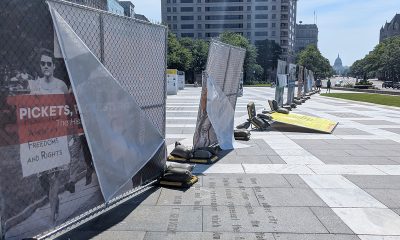Local
Longtime gay activist Frank Kameny dies
Community, public officials mourn loss of LGBT movement hero, pioneer
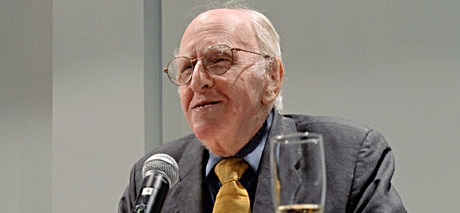
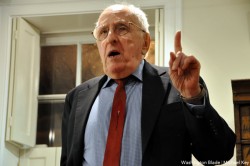
Frank Kameny’s gay rights activism predated the Stonewall riots by more than a decade. (Washington Blade file photo by Michael Key)
Expressions of condolences from LGBT activists and their straight supporters poured in from across the country this week following the death in Washington on Tuesday of Franklin E. Kameny, one of the nation’s most prominent gay rights leaders.
Friends said Kameny, 86, appears to have died in his sleep while in bed at his house in Northwest Washington. A representative of the D.C. Medical Examiner’s office, who spoke to friends and well-wishers who stood outside the house Tuesday night, said the cause of death couldn’t be immediately determined.
Kameny’s passing came a little more than a month before the planned celebration on Nov. 15 of the 50th anniversary of his founding of the Mattachine Society of Washington, the first gay rights organization in the nation’s capital.
LGBT rights advocates Charles Francis and Bob Witeck, who were longtime friends of Kameny’s and established the project to preserve Kameny’s papers over a 50-year period, said they would be announcing soon plans for a memorial service to honor the gay rights leader’s life.
Witeck said Nov. 15 is being considered as a possible date for a Kameny memorial gathering.
Timothy Clark, Kameny’s tenant and friend, said he found Kameny unconscious and unresponsive in his bed shortly after 5 p.m. on Tuesday. Clark said he became concerned when he arrived home a few minutes earlier and noticed Kameny hadn’t retrieved his newspapers, which are delivered outside the house in the morning.
He said he called 911 and rescue workers determined that Kameny had passed away earlier, most likely in his sleep. Clark said he had spoken with Kameny shortly before midnight on the previous day and Kameny didn’t appear to be ill or in distress.
Kameny is credited with being one of the leading strategists for the early gay rights movement – beginning nearly a decade before the 1969 Stonewall riots in New York’s Greenwich Village and continuing forward.
The Stonewall riots, triggered by a police raid of the Stonewall gay bar, are considered by most activist leaders as the starting point of the modern LGBT rights movement. But movement leaders credit Kameny and his collaborators in the Mattachine Society of Washington with laying the groundwork that enabled the post-Stonewall LGBT organizing to flourish.
“Frank was a revolutionary who lived to see the world change, and I’m comforted by that,” said Francis. “He was the first gay American to root the argument for gay civil equality in the words of Thomas Jefferson and the Declaration of Independence and Constitution.”
Gay historian David K. Johnson, who wrote about Kameny in two books on the gay rights movement, said Kameny broke from the early American “homophile” movement’s tactics of accommodation with the prevailing views that homosexuality was a disorder.
“Kameny’s style and tactics differed markedly from those of earlier homosexual leaders,” Johnson wrote in a 2002 article posted on the website of D.C.’s Rainbow History Project. “By unabashedly proclaiming that homosexuality was neither sick nor immoral, Kameny helped move gays and lesbians out of the shadows of 1950s apologetic, self-help groups and into the sunlight of the civil rights movement, setting the tone for a movement that continues today.”
It was during his years as head of the Mattachine Society of Washington that Kameny in July 1968 coined the phrase, “Gay is Good,” which activists say became a forerunner to the gay pride celebrations that followed the 1969 Stonewall riots.
Born and raised in New York City, Kameny served in combat as an Army soldier in World War II in Europe. After the war, Kameny received his doctorate degree in astronomy from Harvard University.
He came to Washington in 1956 to take a position teaching astronomy at Georgetown University. The following year, government recruiters persuaded him to take a job as a civilian astronomer with the U.S. Army Map Service in Washington.
NASA career derailed
Kameny told the Blade in a 2002 interview that the nation’s race against the Soviet Union for superiority in space had just begun in full force and he set his sights, among other things, on a possible role in the U.S. space program.
A short time later, Congress created the National Aeronautics and Space Administration and Kameny said he would have seriously considered applying to become an astronaut. But that was not to come about.
Just five months into his job at the Army Map Service, U.S. government security investigators uncovered information leading them to believe Kameny was gay. They opened an investigation into his alleged “threat” to national security. Within a few weeks he was dismissed from his job, with his name placed on a list of people labeled as government security risks.
Kameny challenged the dismissal before the U.S. Civil Service Commission, which set personnel policies for federal employees. The commission upheld the firing, prompting Kameny to take the matter to court. After losing in the lower courts, he appealed his case to the U.S. Supreme Court, becoming the first known gay person to file a gay-related case before the high court.
The Supreme Court upheld a lower court ruling against Kameny and declined to hear the case. But Kameny’s decision to appeal the case through the court system motivated him to become a lifelong advocate on behalf of LGBT equality.
Gay historian Johnson wrote in his 2002 article that Kameny’s lawyer withdrew from the case after the U.S. Court of Appeals ruled against Kameny, forcing Kameny to write his own appeal to the Supreme Court.
Johnson called Kameny’s 60-page legal brief filed before the high court a groundbreaking challenge to the federal government’s policy barring homosexuals from working for the government in any capacity. Johnson said it served as Kameny’s and the gay movement’s strategy document for advancing legal rights for gays in the years going forward.
Kameny’s Supreme Court brief, or petition, also offered the world its first glimpse of what became his trademark use of blunt, sometimes inflammatory language combined with reasoned arguments to challenge anti-gay policies.
“The government’s regulations, policies, practices and procedures, as applied in the instant case to petitioner specifically, and as applied to homosexuals generally, are a stench in the nostrils of decent people, an offense against morality, an abandonment of reason, an affront to human dignity, an improper restraint upon proper freedom and liberty, a disgrace to any civilized society, and a violation of all that this nation stands for,” he wrote in his Supreme Court petition.
“These policies, practices, procedures, and regulations have gone too long unquestioned and too long unexamined by the courts,” he wrote.
Gov’t apologizes to Kameny
Although Kameny lost his own case, he spent the next decade working with attorneys and other gay and lesbian federal workers to chip away at the then U.S. Civil Service Commission’s ban on gay federal employees through new court challenges. By 1975, after losing several cases to gay employees who won reinstatement to their jobs over a period of years, the Civil Service Commission dropped its ban on gay employees.
The change, which came under the administration of President Gerald Ford, was based on court rulings saying the government could not discriminate against homosexual federal employees if no evidence exists to show a harmful “nexus” between someone’s sexual orientation and their ability to perform their job.
Kameny, who called the development a major victory for gay rights, turned next to ongoing efforts to end two other anti-gay policies of the government – the ban on gays from receiving government security clearances and the ban on gays in the military.
In 2009, the Obama administration through the U.S. Office of Personnel Management – the successor agency to the Civil Service Commission – issued Kameny a formal apology for his 1957 firing. The apology was extended by OPM Director John Berry, an openly gay man.
In an area of work for which Kameny is less known, he established a paralegal practice in the 1970s that continued through the 1980s and early 90s to represent gays encountering problems obtaining or retaining security clearances as well as gays facing discharge from the military because of their sexual orientation.
Activists following his paralegal work, including those who he helped keep their security clearances, called Kameny a tenacious counsel who sometimes worked with lawyers and other times served as an administrative representative before adjudicatory hearings, including discharge hearings in all branches of the military.
“When the super-secret National Security Agency (NSA) was on the verge of firing me simply for discovering I was gay, I enlisted Frank Kameny’s help in resisting,” said Jamie Shoemaker, a linguist and NSA career employee.
“His gutsy, unapologetic efforts to save my career and that of many others with security clearances led to a ground-breaking change in the attitude of our country’s intelligence agencies toward gays,” Shoemaker said.
Kameny said he was pleased when his security clearance practice became mostly unnecessary in the 1990s when President Bill Clinton issued an executive order prohibiting discrimination based on sexual orientation in the issuance of government security clearances.
Soliciting sodomy
In his work with military service members ensnared in what activists called witch hunts, where military investigators pressured vulnerable gays to identify other gays under false promises of lenient treatment, Kameny coined another phrase aimed at helping those under investigation – “Say nothing, sign nothing, get counsel.”
Charles Francis and others who knew Kameny said his paralegal work met an important need in the years before groups such as Lambda Legal Defense and Education Fund and Servicemembers Legal Defense Network emerged to take on this type of legal work.
LGBT movement colleagues also credit Kameny with playing a lead role in the effort to persuade the American Psychiatric Association in 1973 to remove homosexuality from its list of disorders. As a scientist by profession, Kameny wrote and spoke often beginning in the 1960s about what he called the faulty or “junk” science that the psychiatric profession used to support its claim that homosexuality was a mental disorder.
Kameny and others supporting him within the profession argued that nearly all of the “gays are sick” theories were based on studies of patients in therapy. There were little or no studies made of the overwhelming majority of gays who never sought therapy and functioned well in society despite widespread anti-gay prejudice, Kameny and others argued.
When broader studies were conducted of gays and lesbians in the population at large, findings showed there were no differences in the numbers found to have mental health problems between samples of gays and straights, Kameny often pointed out.
In yet another area of work, Kameny is credited with playing an early and effective role in pushing for repeal of state sodomy laws, which made it illegal for consenting adults to engage in oral or anal sex in the privacy of the home. In keeping with his characteristic defiant rhetoric, Kameny sought to dramatize what he called the “lunacy” of laws prohibiting private, consenting sex.
On a number of occasions he publicly solicited public officials, including D.C.’s police chief in the 1960s, to engage in sodomy with him. In 1987, when the U.S. Supreme Court upheld Georgia’s sodomy law in the case Bowers vs. Hardwick, Kameny said he wrote letters soliciting sodomy to each of the Supreme Court justices that voted to uphold the law.
“I defied them to prosecute me,” he told the Blade. “They never did.”
Joe Solmonese, president of the Human Rights Campaign, said Kameny “led an extraordinary life marked by heroic activism that set a path for the modern LGBT civil rights movement.”
“From the early days fighting institutionalized discrimination in the federal workforce, Dr. Kameny taught us all that ‘Gay is Good,’” Solmonese said. “As we say goodbye to this trailblazer on National Coming Out Day, we remember the remarkable power we all have to change the world by living our lives like Frank – openly, honestly and authentically.”
Chuck Wolfe, CEO of the Gay & Lesbian Victory Fund, said Kameny’s death marked the “loss of a hero and a founding father of the fight to end discrimination against LGBT people.”
“Dr. Kameny stood up for this community when doing so was considered unthinkable and even shocking, and he continued to do so throughout his life,” Wolfe said. “He spoke with a clear voice and firm conviction about the humanity and dignity of people who were gay, long before it was safe for him to do so. All of us who today endeavor to complete the work he began a half century ago are indebted to Dr. Kameny and his remarkable bravery and commitment.”
Local activists who knew Kameny said they are deeply saddened over his passing but pleased to have shared time with him at several LGBT events in Washington during the past three weeks.
On Sept. 30, D.C.’s LGBT Community Center honored Kameny along with three other activists with its community service award at a ceremony at the downtown Hotel Sofitel. Kameny delivered what his activist friends called his standard and beloved fiery speech asserting his 50-year struggle to change society to bring about full and unabridged rights for LGBT people. It was to be his last speaking engagement.
His passing inside his house on Tuesday came several years after the city designated the house at 5020 Cathedral Ave., N.W., as a historic landmark because of the work Kameny and his activist colleagues performed there since the 1960s on behalf of LGBT rights. In 2010, the D.C. City Council voted unanimously to name a two-block section of 17th Street near Dupont Circle as Frank Kameny Way in honor of Kameny’s lifelong work on behalf of equality for the LGBT community and the community at large.”
Kameny’s death also came five years after Francis and Witeck helped arrange for the Library of Congress to acquire more than 50,000 documents from the Kameny Papers Project, which pulled together nearly 50 years of papers and documents that Kameny compiled through his work on behalf of LGBT people.
“Frank Kameny was the Rosa Parks and the Martin Luther King and the Thurgood Marshall of the gay rights movement,” Yale Law Professor William Eskridge told the Associated Press earlier this year.
Virginia
Va. court allows conversion therapy despite law banning it
Judge in June 30 ruling cited religious freedom.
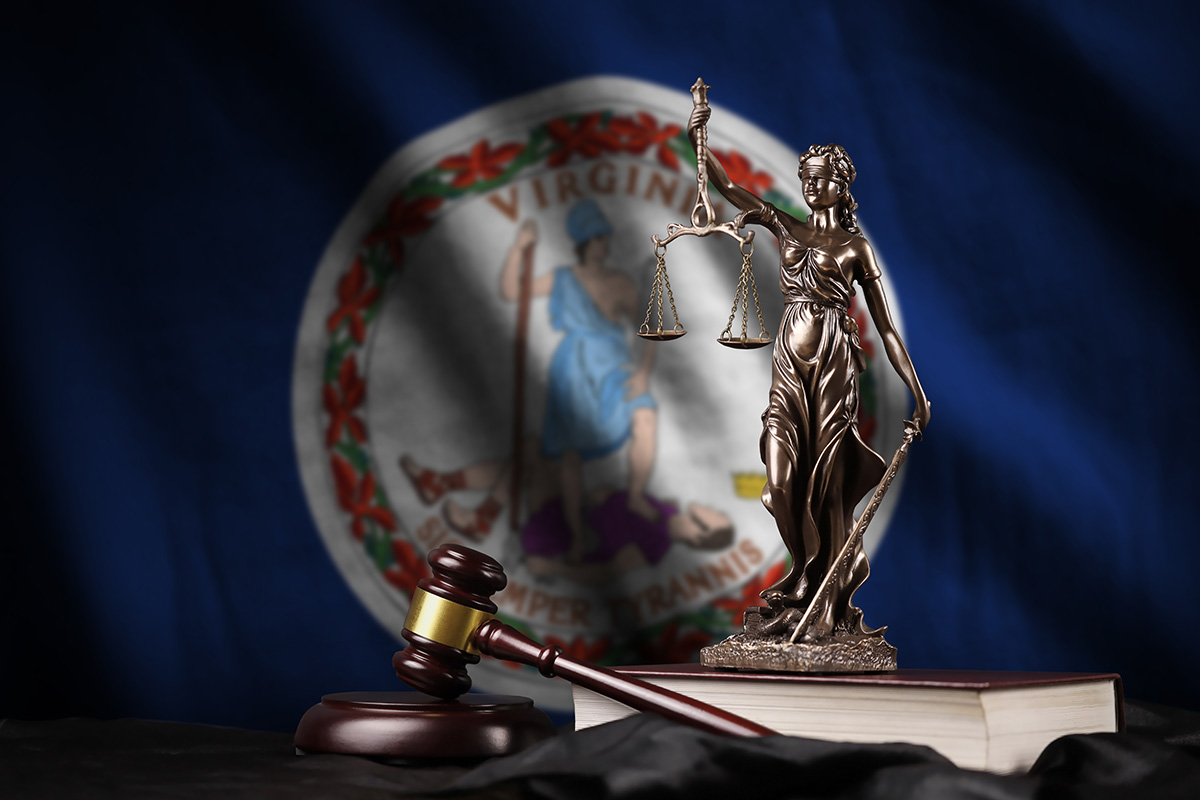
In 2020, the state of Virginia had banned the practice of conversion therapy, but on Monday, a county judge ruled the ban violates the Virginia Constitution and Religious Freedom Restoration Act, allowing the therapy to start once more.
The conversion therapy ban, which can be seen in Va. Code § 54.1-2409.5 and 18VAC115-20-130.14, was overturned on June 30 as a result of two Christian counselors who argued that their — and all Virginia parents’ — constitutional right to freedom of religion had been encroached upon when the state legislature passed the ban.
A Henrico County Circuit Court judge sided with John and Janet Raymond, two Christian counselors represented by the Founding Freedoms Law Center, a conservative organization founded in 2020 following Virginia’s conversion therapy ban. Virginia’s Office of the Attorney General entered a consent decree with FFLC, saying state officials will not discipline counselors who engage in talk conversion therapy.
Conversion therapy, as the legislation described it, is considered to be “any practice or treatment that seeks to change an individual’s sexual orientation or gender identity, including efforts to change behaviors or gender expressions or to eliminate or reduce sexual or romantic attractions or feelings toward individuals of the same gender.” The ban’s reversal will now allow parents to subject their children to these practices to make them align better with their religion.
This decision comes despite advice and concern from many medical and pediatric organizations — including the American Psychiatric Association, American Psychological Association, American Association for Marriage and Family Therapy, and the American Counseling Association, to name a few — all of which denounce conversion therapy as dangerous and harmful to those subjected to it.
The American Medical Association, the largest and only national association that convenes more than 190 state and specialty medical societies, says that “these techniques are the assumption that any non-heterosexual, non-cisgender identities are mental disorders, and that sexual orientation and gender identity can and should be changed. This assumption is not based on medical and scientific evidence,” with attached data indicating people subjected to conversion therapy are more likely to develop “significant long-term harm” as a result of the therapy.
The AMA goes as far as to say that they outright “oppose the use of reparative or conversion therapy for sexual orientation or gender identity.”
FFLC has a clear goal of promoting — if not requiring — conservative ideology under the guise of religious freedom in the Virginia General Assembly. On their website, the FFLC argues that some progressive policies passed by the Assembly, like that of freedom from conversion therapy, are a violation of some Virginians’ “God-given foundational freedoms.”
The FFLC has argued that when conservative notions are not abided by in state law — especially when it involves “God’s design for male and female, the nuclear family, and parental rights” — that the law violates Virginians’ religious freedom.
A statement on the FFLC’s website calls gender dysphoria among children a “contagion” and upholds “faith-based insights” from counselors as equal — in the eyes of the law — to those who use medical-based insights. This, once again, is despite overwhelming medical evidence that indicates conversion therapy is harmful.
One study showed that 77 percent of those who received “sexual orientation change efforts,” or conversion therapy, experienced “significant harm.” This harm includes depression, anxiety, lowered self-esteem, and internalized homophobia. In addition, the study found that young LGBTQ adults with high levels of parental or caregiver rejection are “8.4 times more likely to report having attempted suicide,” with another study finding that “nearly 30 percent of individuals who underwent SOCE reported suicidal attempts.”
Virginia Senate Majority Leader Scott Surovell, a Democrat representing Fairfax, said that the overturning of the ban on religious merit disregards the entire concept of having professionally licensed counselors.
“I have no problem if somebody wants to go look at religious counseling from their priest or their minister, their rabbi, their imam — that’s perfectly fine,” Surovell told the Virginia Mercury. “When somebody goes to get therapy from somebody licensed by the commonwealth of Virginia, there’s a different set of rules applied. You can’t just say whatever you want because you have a license. That’s why we have professional standards, that’s why we have statutes.”
District of Columbia
GenOUT Chorus offers solace, strength to LGBTQ teens
Summer camp held from June 23-27
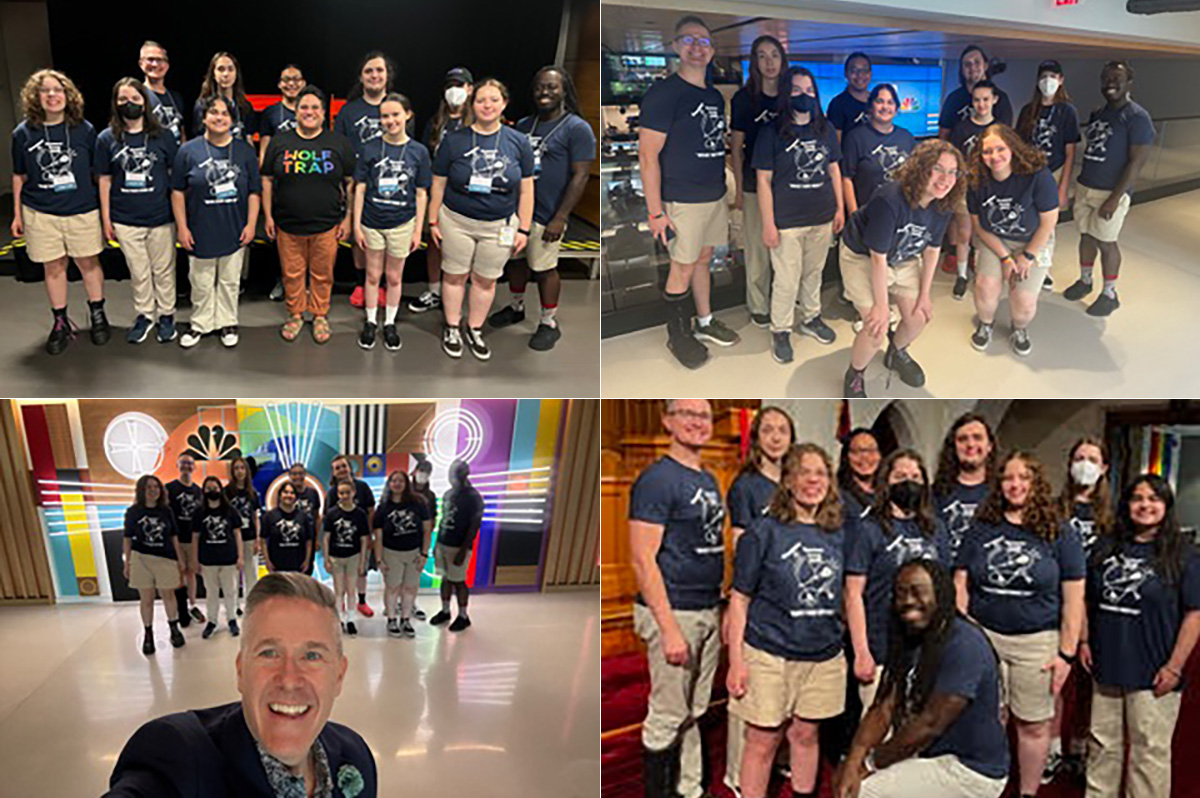
As Pride month draws to a close and Washington begins to take down its rainbow flags and WorldPride decorations, it can be easy to confine the ideas of LGBTQ liberation to June. One historic organization in Washington has been speaking out — or singing out if you will — to ensure that LGBTQ youth are allowed to explore and be themselves every month of the year.
The Gay Men’s Chorus of Washington is one of the oldest and largest LGBTQ choruses in the world. With more than 300 members and more than 40 years in the D.C. LGBTQ community, to say it is an institution would be an understatement.
Beginning in 1981, following an inspiring performance by the San Francisco Gay Men’s Chorus at the Kennedy Center, a group of 18 gay men — led by a “straight” woman and friend of Washington’s gay community, Marsha Pearson — created the GMCW. Since its establishment the organization has only grown in number and relevance within the city. From hosting multiple concerts a year, international equality trips, and creating a dedicated space to “inspire equality and inclusion with musical performances and education,” the GMCW is one of the cornerstone organizations in the Washington LGBTQ community.
One of the most remarkable parts of the GMCW is its youth outreach program and choir: GenOUT. The outreach ensemble specializes in providing a space for Washington’s LGBTQ and allied youth, ages 13-18, to find their voice through song and connect that voice to community. The GenOUT program has been around since 2001, and since 2015 has provided a platform for their voices to be heard — literally — making it the first LGBTQ youth chorus in the Washington area.
The Washington Blade sat down with GenOUT Director C. Paul Heins and member Ailsa Ostovitz to discuss why GenOUT, and more specifically the GenOUT summer camp, which was held from June 23-27, has become an essential space for LGBTQ youth in the D.C. area to find their voice amid less-than-supportive administration and rising anti-LGBTQ rhetoric in the nation.
“This is my 11th season with GenOUT, and also the 11th season with Gay Men’s Chorus of Washington,” Heins said when explaining how he ended up in the director role for the self-selected, no audition required youth outreach ensemble. “I was hired in August of 2014 to start GenOUT. I spent that first fall researching other choruses, figuring out the infrastructure, promoting the chorus, and building relationships with schools, organizations, and faith communities. And then we started in January of 2015 with nine brave singers and since then, we’ve had 150+ singers from 80 or more schools in the DMV participate.”
Ailsa Ostovitz, on the other hand, being in high school had not had as much experience with choirs — yet her commitment and unwavering passion for the work she — and the other performers within GenOUT provide to each other was unmistakable.
“I’ve been a part of the course since April of 2022, and that was like seventh grade— which is wild to think about,” Ostovitz said when reflecting on how long she had been a part of GenOUT. She explained how she had begun to develop a drive for filling leadership roles within GenOUT after gaining valuable experiences and education from the organization.
“This is my first year in leadership,” she added. “The rest of the years, I kind of hung back. I really wanted to — especially last season — kind of put myself in the position of a peer and think ‘What would I want from people that are supposed to represent me to the adults? What would I want out of that?’”
And with those questions in mind, Ostovitz explained she buckled down and worked hard to get to where she is now as a member of the leadership team within the GenOUT choir.
“I spent a lot of time working with my section leader, and, looking up at him and being like, ‘What are you doing now that I can do in the future?’ And so this year, I ran for leadership,” Ostovitz said. “I got section leader, and that was cool. I’ve just spent a lot of time — most of my time in this course — learning leadership skills to kind of help me in all sorts of things in life, because I like to take control of things, and I like doing stuff.”
These leadership skills are just a handful of the things that students like Ostovitz learn while participating in the program. This year’s theme was “Make Them Hear Us!: Empowering LGBTQ+ and Allied Youth Through Music, Media, and Community,” and provided multiple opportunities for GenOUT’s members to engage with new concepts, ideas, and experiences.
From field trips to mentoring opportunities to an end-of-camp performance, it becomes clear when speaking to those familiar with the GenOUT experience: it is not your traditional summer day camp.
“The title of the camp references the anthem that GMCW has sung for many years,” Heins said. “‘Make Them Hear You’ from the musical ‘Ragtime’ encourages us to share important stories — stories that honor the fights that we’ve been fighting, the rights that we have won, affirmations that we seek for every human being, and the focus on media — specifically developing young people’s understandings of the kinds of media that they can access and use to share their voice.”
The camp offers singing and dancing lessons, creative writing exercises, LGBTQ+ history lessons, and open discussions about identity — providing an outlet for students to figure out who they want to be and find their voice.
“What this camp does, I believe, is it helps foster young people’s voices and not only encourages them to speak, but to give them the skills to speak in a way that will be heard meaningfully,” Heins added. “I have noted that youth in queer choruses like GenOUT have said that singing in a chorus allows young people to express themselves more honestly and with greater passion than other forms of expression. They’ve also said that singing with others that understand you on a very deep, profound level, makes the expression much easier and more beautiful. I think that experience is what really makes this a special opportunity for young, LGBTQ and allied people.”
Ostovitz echoed Heins’s sentiment, emphasizing that the space GenOUT provides allows her to feel empowered in ways more than by creating leadership skills that will help her later in life. GenOUT has allowed for her to see the humanity and similarities LGBTQ youth all face in a straight world.
“Joining the chorus and being in this camp, it really gives people a chance to see that every person is going through the same experience you are, on a level of finding your own identity and being confident in that,” Ostovitz said. “It really, really serves a purpose by showing there are still queer people. They’re not fizzling out — young people are queer. We want to use our voices to express what we feel and how things are affecting us, and I think that using music to do that is probably one of the most powerful ways to do that.”
In addition to allowing for internal growth and honing their singing abilities, both Ostovitz and Heins pointed out the other valuable skills students learn while in the GenOUT program. Ostovitz explicitly highlighted the mentorship program GenOUT has with GMCW, and how it has helped students like her figure out their future.
“Because we are so connected with GMCW, we run a mentorship program where, if you want to explore career, identity, whatever, we can connect you with somebody from GMCW,” Ostovitz said. “You get to spend a whole semester with a person working on your voice or your career or your what you want to do in higher education. It’s not only for things related to your queer identity, but it’s also just for life. It’s really cool.”

This year’s theme, centering around media and the many ways people can share their voice, was highlighted through the camp’s field trips to two legacy media organizations — WAMU and NBC Washington — and a discussion with staff from the Washington Blade, including Publisher Lynne Brown and International News Editor Michael K. Lavers.
“GenOUT provides a chance to get to know people from all around this area, but it also connects you to older folks, It connects you to people from the past, as well as we learn about LGBTQ history,” Heins said. “I think a camp specific thing is we want young people to understand how they can share their stories beyond just talking to their friends. There are these forms of media that are out there to share your stories, to have your voices heard, and to have a sense that these media are there for everyone. It’s not just a thing for people aged 21 and over. That was something that Lynne and Michael from the Blade were sharing with; that anyone can write in a letter to the editor. It doesn’t mean it’s going to be published, but that anyone has that opportunity. And I think that’s a great way for them to say the Blade is open to you to share your voice.”
The concept that there are people who want to, or may need to hear queer voices represented is one that is not lost on Ostovitz.
“There is something Thea says that has kind of integrated into our chorus — that someone out there needed to hear you, needed to hear your voice, needed to hear your story,” Ostovitz said. “That’s something that I kind of live by in this chorus, where I’m like, ‘I believe that there is someone out there that needed to hear this song for whatever reason, whatever it did for them. And I’m hoping to learn how much more can this chorus do for not just our little community, but how much more can it do around the world or the country — especially now.”
Living in the political center of the U.S., Ostovitz explained, has impacted how she approaches her identity, her education, and the urgency of using her voice — both as a student and as a young queer person navigating an increasingly hostile national climate.
“Being so close to the political center of the country and also a student at the same time has not been the easiest thing in the world as of late,” she said. “You’re thinking a lot about ‘Oh, I wonder if this program in my school will still exist next year,’ because a lot of the funding for physics and science programs in general has been cut. So I’m fortunate enough that Maryland has been pretty good about going against this administration. And so being in this chorus gives me a second to step back from my academics and just go somewhere for the two hours of rehearsal.”
For Ostovitz, just having those two short hours a week to focus on music — without thinking about the political climate that paints her and her choir peers as nefarious for being LGBTQ — provides solace.
“Everybody else is going through the same thing as I am, but we’re all also working towards the same goal, which is acceptance and uplifting of everybody and everyone — no matter who they are,” she said. “It kind of settles you down and grounds you. And then you just make music with people, and it’s really like a stress reducer for me.”
“Is it too trite to say that that would make people feel less alone, knowing that it’s not just a DMV thing, but that there are queer people all over?” Heins asked Ostovitz.
“No, it’s not — for sure,” Ostovitz responded. “It was a bit eye-opening.”
“A lot of us are fortunate enough to have families that support us enough to trust us and help us be passionate and mean what we do with the work that we do in this chorus — because it is optional,” Ostovitz added. “It is optional to have the courage that we have to practice and commit as much as we do, and the fact that we have a whole organization backing us on that is pretty cool.”
“We often say that we sing for those who can’t sing in a chorus like ours,” Heins said. “We sing for people who don’t have the freedom or the option to live their authentic lives. I think that’s very powerful.”
“It’s a very unique experience to be surrounded by so many people that get it,” Ostovitz said. “It’s a very joyful experience when we perform our big shows at the Lincoln Theater, being part of that production is also a very unique experience. So I think everything about this chorus is very joyfully unique.”
“I feel very proud, and I feel very inspired,” Heins said. “I feel inspired by the young voices. I feel a sense of inspiration in my own music-making, when I am able to take a piece from its very beginning all the way to the stage in a polished form. And I feel that sense of pride in knowing that I’ve helped this group of young people develop their confidence to do really amazing things.”
“GenOUT sang 22 times last year, which for any chorus is a big deal, but for a youth chorus coming from thither and yon, it is really a big deal,” Heins added. “I’m just really inspired and proud, and know that when I am in a nursing home somewhere and these folks are still out working and I know the country will be in good hands.”
Virginia
Walkinshaw wins Democratic primary in Va. 11th Congressional District
Special election winner will succeed Gerry Connolly
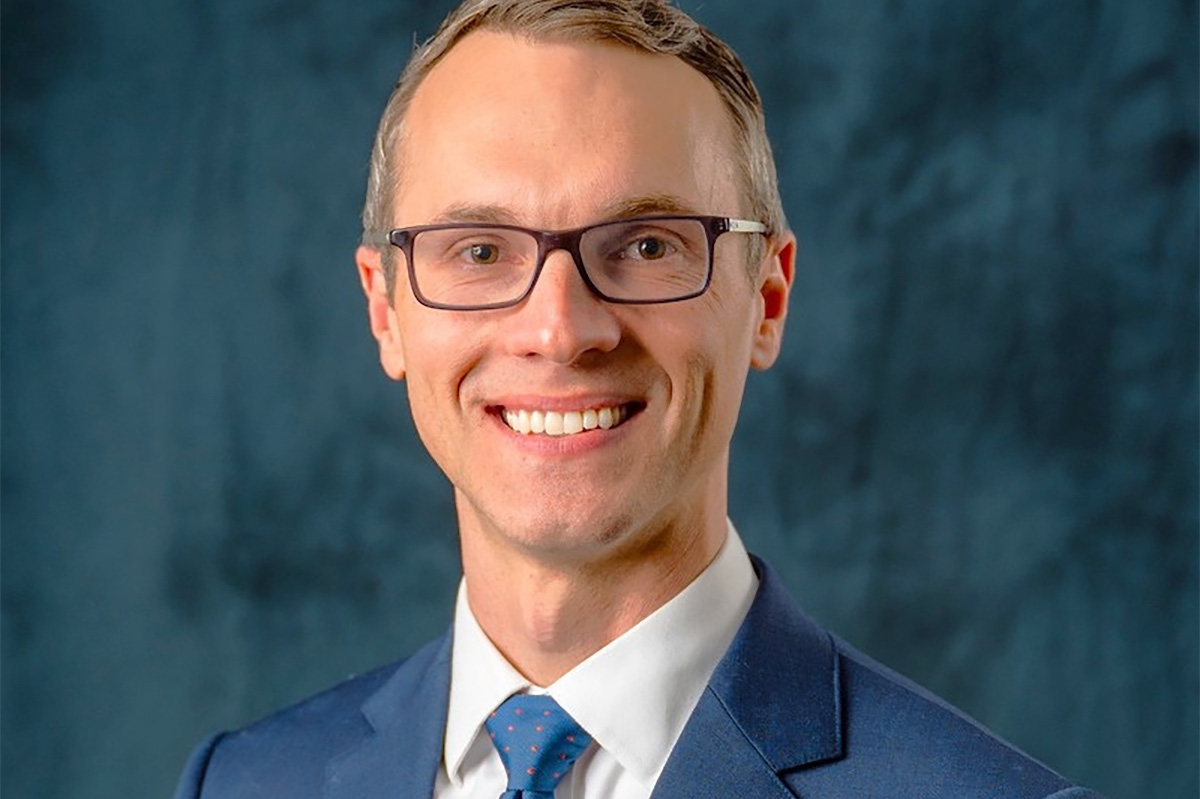
On Saturday, Fairfax County Supervisor James Walkinshaw won the Democratic primary for the special election that will determine who will represent Virginia’s 11th Congressional District.
The special election is being held following the death of the late Congressman Gerry Connolly, who represented the district from 2008 until 2024, when he announced his retirement, and subsequently passed away from cancer in May.
Walkinshaw is not unknown to Virginia’s 11th District — he has served on the Fairfax County Board of Supervisors since 2020 and had served as Connolly’s chief of staff from 2009 to 2019. Before he passed away, Connolly had endorsed Walkinshaw to take his place, claiming that choosing Walkinshaw to be his chief of staff was “one of the best decisions I ever made.”
The Democratic nominee has run his campaign on mitigating Trump’s “dangerous” agenda of dismantling the federal bureaucracy, which in the district is a major issue as many of the district’s residents are federal employees and contractors.
“I’m honored and humbled to have earned the Democratic nomination for the district I’ve spent my career serving,” Walkinshaw said on X. “This victory was powered by neighbors, volunteers, and supporters who believe in protecting our democracy, defending our freedoms, and delivering for working families.”
In addition to protecting federal workers, Walkinshaw has a long list of progressive priorities — some of which include creating affordable housing, reducing gun violence, expanding immigrant protections, and “advancing equality for all” by adding sexual orientation and gender identity to the Fair Housing Act.
Various democratic PACs contributed more than $2 million to Walkinshaw’s ad campaigns, much of which touted his connection to Connolly.
Walkinshaw will face Republican Stewart Whitson in the special election in September, where he is the likely favorite to win.
-

 U.S. Supreme Court3 days ago
U.S. Supreme Court3 days agoSupreme Court to consider bans on trans athletes in school sports
-

 Out & About3 days ago
Out & About3 days agoCelebrate the Fourth of July the gay way!
-

 Virginia3 days ago
Virginia3 days agoVa. court allows conversion therapy despite law banning it
-
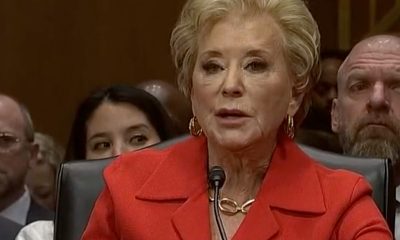
 Federal Government5 days ago
Federal Government5 days agoUPenn erases Lia Thomas’s records as part of settlement with White House

